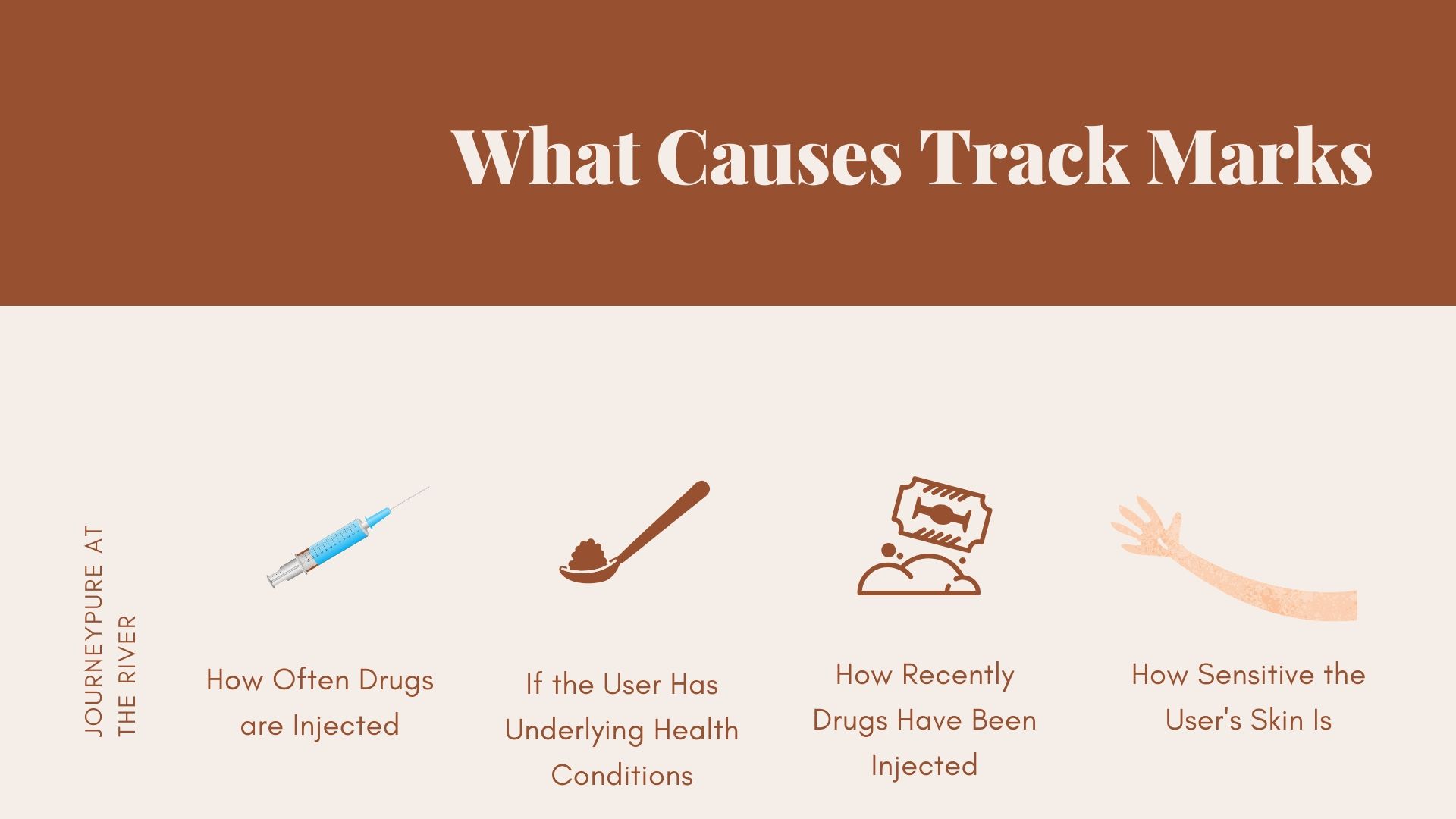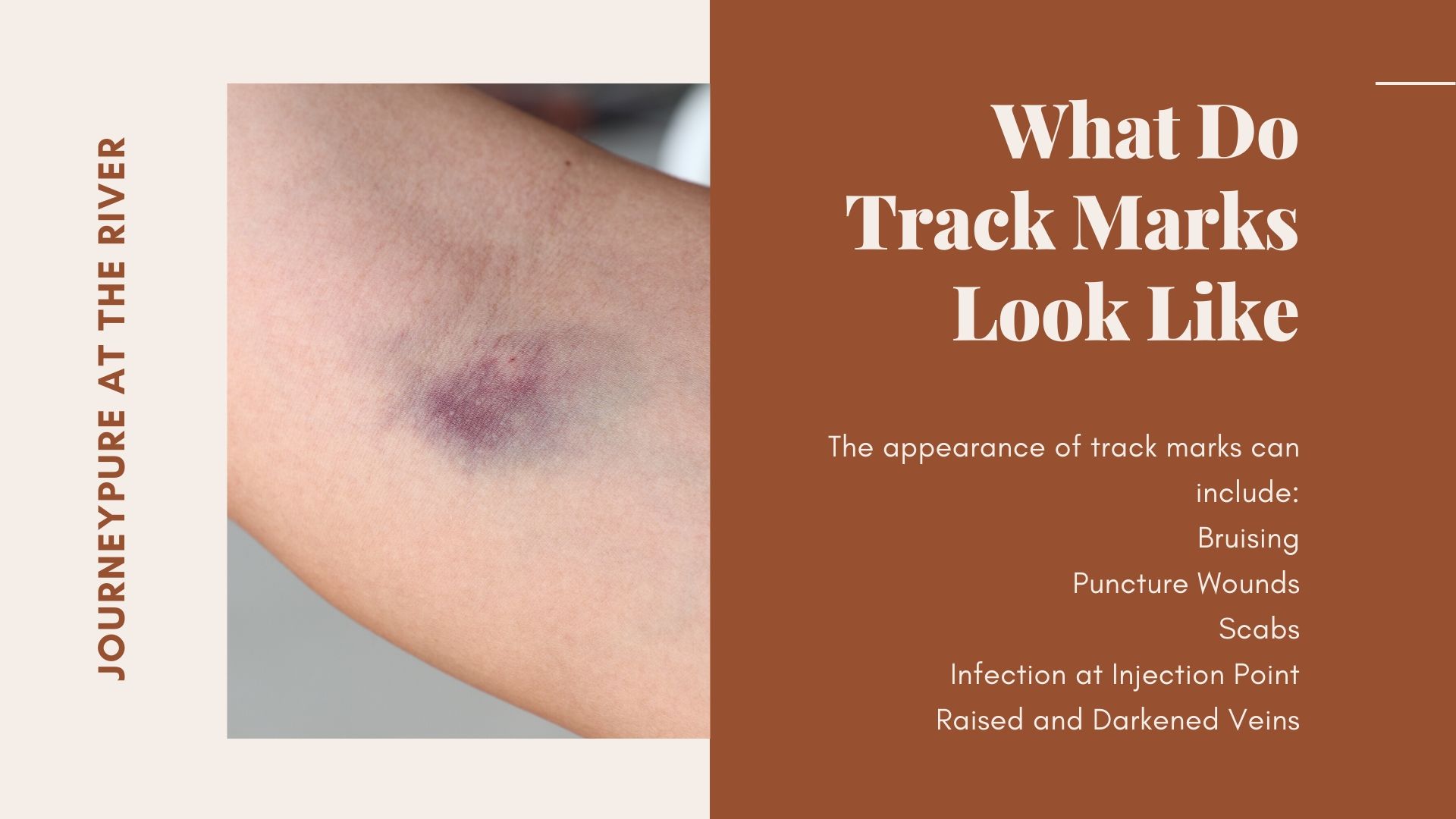The vast majority of drug users do not begin their drug use by injecting drugs, rather it usually takes some time for them to reach that point (if ever). Part of this is because drug users do not need to get that high that quickly when they first start out using, or even near the prime of their use. They can still get high and be satisfied with that high by snorting, smoking, or swallowing drugs. But, as tolerance builds and dependence increases, injecting drugs starts to be more appealing because of how powerful this form of transmission is. It is rare for someone who begins injecting drugs to stop and return to other methods of consumption, making it likely for physical health issues to develop. Of the most noticeable and potentially dangerous physical problems associated with intravenous drug use are track marks. Track marks are the scars that form as a result of continued intravenous drug use, they often look like bruises with small dark dots at the point of injection.
Many opioid users are intravenous drug users, as are those who are hooked on other addictive drugs like those previously mentioned. The idea of injecting drugs into one’s body can seem unfathomable to many, especially those who are not struggling with addiction. It is definitely not what any drug addict ever imagined themselves doing, however it happens and does so frequently.
When drugs are snorted, smoked, or swallowed, the effects they are designed to produce don’t occur immediately, rather take a bit of time to kick in. Drugs that are snorted begin working the fastest and within a matter of minutes, while it can take longer for drugs that are smoked or swallowed to take effect. But, when drugs are injected directly into the veins, the high is near immediate and is much more powerful than the high produced via any other form of consumption.

What Are Track Marks?
Track marks are the physical scarring that occurs after someone has intravenously abused drugs. It is common to see profound track marks on those individuals who are struggling with a severe drug addiction because they are regularly injecting drugs and causing this scarring to occur. And while the most profound track marks are usually seen on the most heavily addicted individuals, they can happen to any intravenous drug user at any point in time.
Why Do Track Marks Happen?
Track marks happen because of the damage that the user is doing to his or her veins with intravenous drug use. Consistently injecting a needle into the same spots on the body and fishing around disrupts the skin natural barriers and bruises and mutilates the veins in that area. Despite being responsible for helping to keep the human body alive, veins are very sensitive. They are so sensitive that even getting a simple blood test done can leave behind a bruise that lasts for days. Constantly fiddling with them in order to regularly inject drugs disrupts their healthy function and, in turn, their appearance through the skin.

What Do Track Marks Look Like?
The appearance of track marks are often determined by several factors, including:
- How often drugs are being injected
- How recently drugs have been injected
- How sensitive the user’s skin is
- If the user has underlying health conditions
The injection site on a track mark can appear bruised, punctured, or scabbed over. There may even be active bleeding or dried blood around the injection site, especially if it is fresh. As intravenous drug use continues, track marks often worsen in appearance. Not only will they have bruises and scabs, but they can also be defined by dried cracked skin and skin that appears infected (e.g. red, inflamed, or excreting discharge). The veins that are used most can become raised and darken in color. This can cause the track marks to stand out against the rest of the skin.
It is a common misconception that track marks only occur on the arms. Unfortunately, drug users tend to frequent several different veins in various areas of the body, such as those veins in the hands, between the toes and the groin, to name a few. Track marks can be present in those areas, too.
What Does a Collapsed Vein Look Like?
Collapsed veins, which are also known as blown veins, occur when veins collapse in on themselves, preventing the proper flow of blood. This can cause the vein to appear black and blue and possibly even swollen. When a vein collapses, it can cause a sharp pain around the injection site and become extremely itchy. The itch is caused by blood attempting to make its way through the collapsed vein, however scratching at this itch can prevent that blood from trying to recirculate. When the vein has collapsed to the point where no blood can pass, extremities such as hands and feet can become cold and bluish. Collapsed veins do not always heal, however some can with the right care.
Addiction recovery that’s built to last
What To Do If Someone You Love Has Track Marks
If someone you love has track marks, it likely means that he or she is suffering from a serious substance use disorder. If you are seeing track marks, chances are that you are already aware of your loved one’s substance abuse, especially if you see him or her regularly. Upon seeing these marks, you may want to tell your loved one to stop using immediately. You may even become upset to the point where an argument breaks out. The most important thing you can do when you see track marks on a loved one is to keep your composure. Lecturing your loved one or yelling at them is not going to make the situation any better. Some things you can do if you see track marks on your loved one can include:
- Speaking with your loved one when he/she is not under the influence to express your deep concern for his/her wellbeing
- Researching treatment facilities in your area that may be able to help your loved one
- Contacting an interventionist if you feel like you need professional support to encourage your loved one to get help
- Getting help for yourself by seeing a therapist, going to support groups meetings, and practicing good self-care
The most important thing that you can do when you see that your loved one is using to the point of developing track marks is to help guide him or her towards professional help. If your loved one accepts help, he or she can not only be treated for his or her substance use disorder, but also receive treatment for any physical issues, specifically those related to their veins.
Collapsed veins caused by intravenous drug use can be extremely dangerous, as it can restrict blood flow in the body and jeopardize one’s life. In many cases, collapsed veins do not present such a severe risk, but anytime veins have blown, it is important to get them treated. Seeking professional addiction treatment can help get that process started, as the most important action that needs to be taken to help potentially heal a collapsed vein is to stop injecting into it. Very rarely does an intravenous drug user stop using long enough for a vein to heal, which is why having the support of professionals can be key. From there, allowing time for the vein to heal by not injecting into it remains the most important form of treatment. In addition, individuals attempting to heal their blown veins can take specific vitamins and supplements (such as vitamin C) to help reduce inflammation in the vein.
Does Someone You Love Need Help? Call JourneyPure Today
Watching someone you love struggle with drug addiction is extremely difficult. At times, it can even be maddening. Knowing that your loved one is injecting drugs can make the light at the end of the tunnel seem farther away than ever before. The good news is that despite the severity of your loved one’s addiction, there are treatment options that can help.
At JourneyPure at The River, we not only offer unparalleled support and guidance, but we also provide the most up-to-date, evidence-based treatments in our patients’ care plans. We treat the disease of addiction as the physical, mental, emotional, and spiritual disease that it is so that all of our patients can heal from the inside out.
You are not alone. Call JourneyPure at The River right now to learn more about how we can help you and your loved one.
